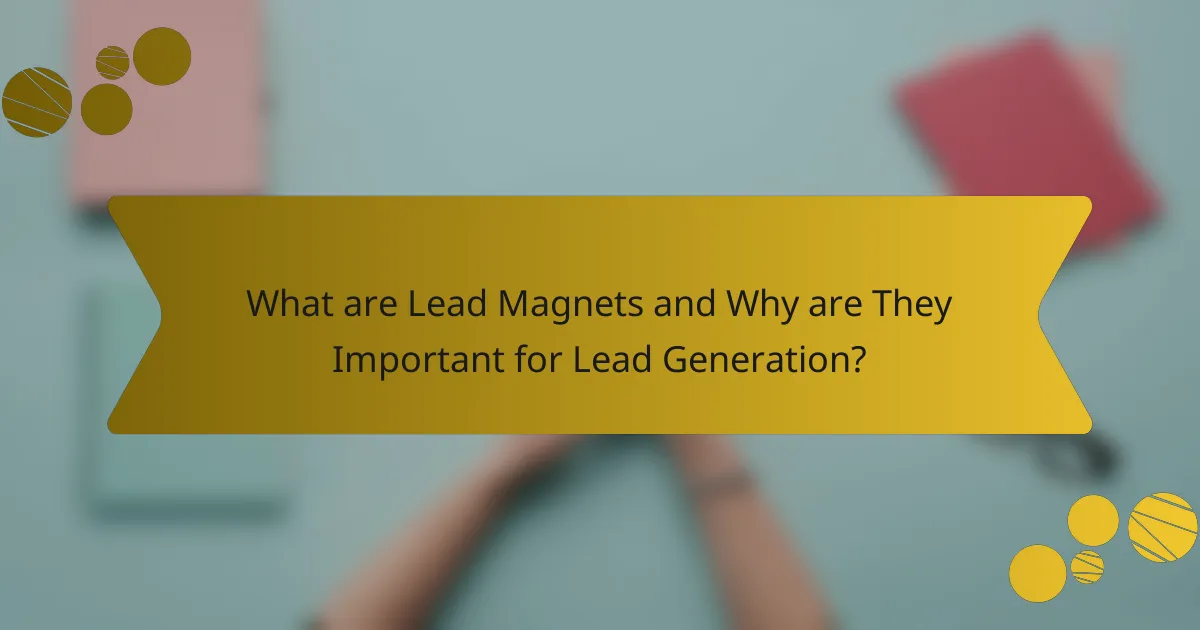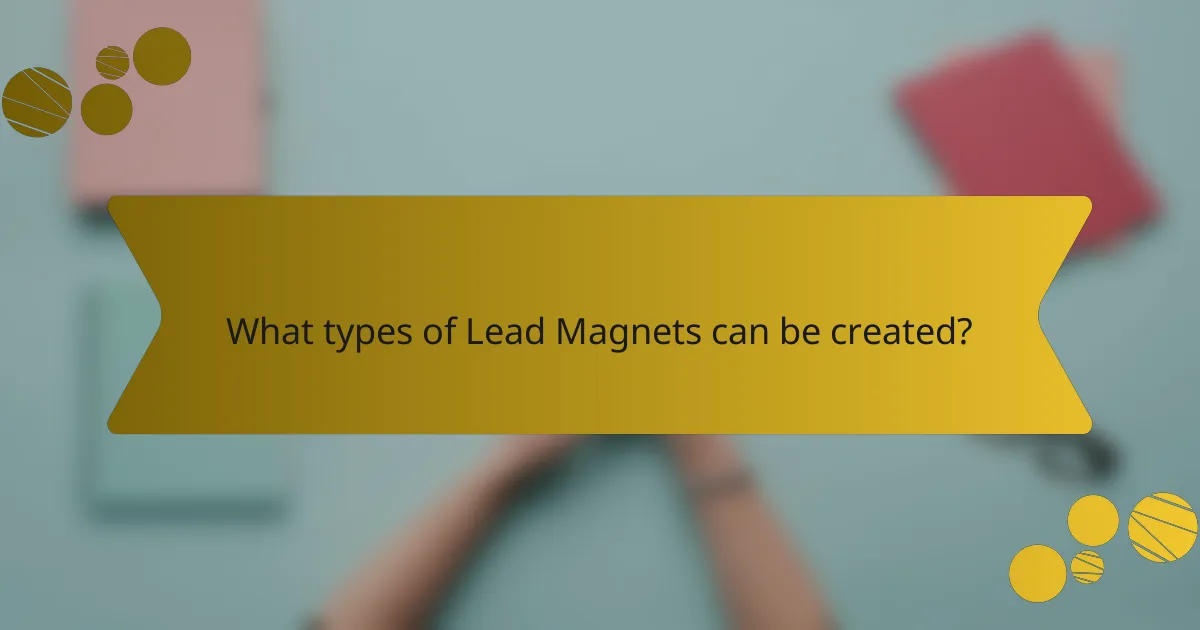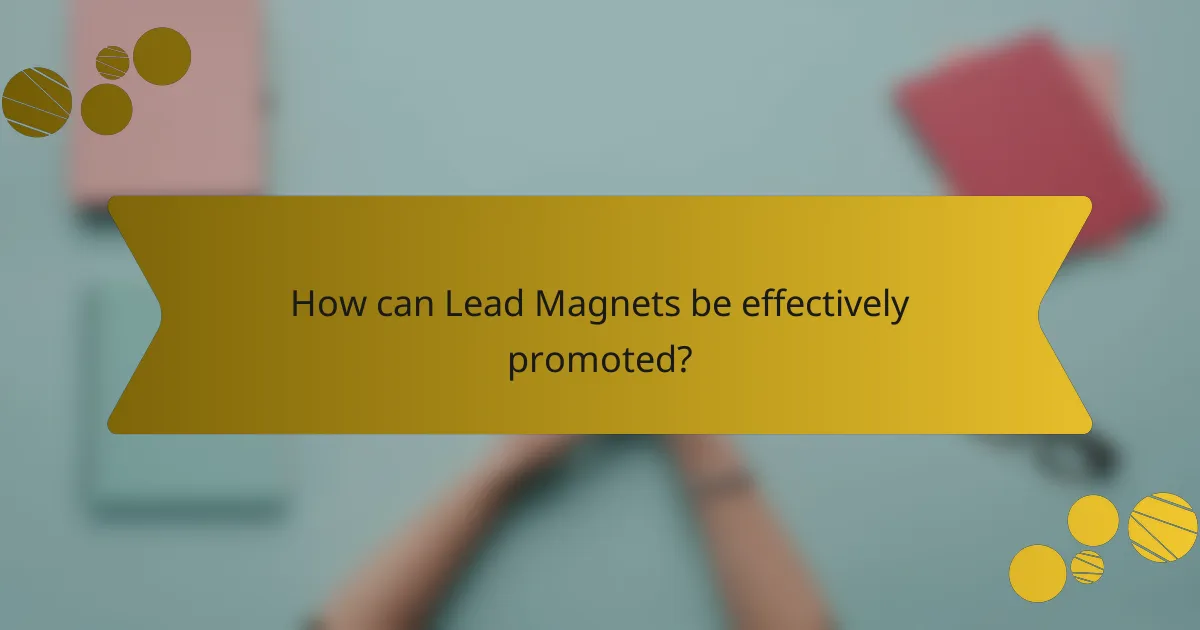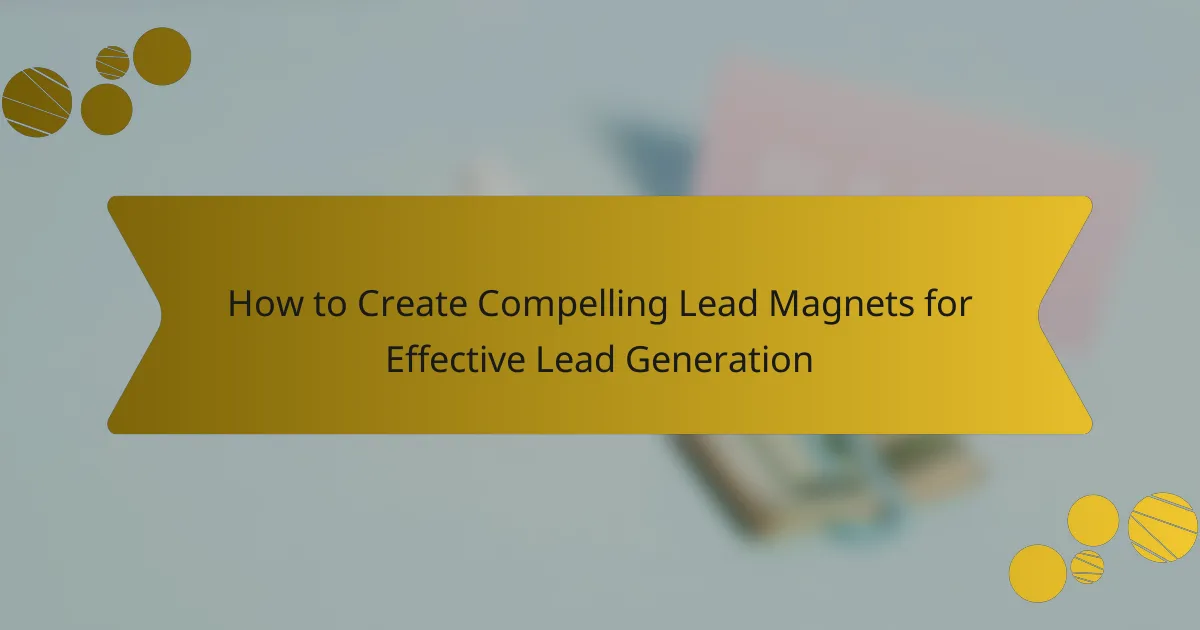Lead magnets are valuable resources provided to potential customers in exchange for their contact information, playing a crucial role in lead generation. This article outlines various types of lead magnets, including eBooks, webinars, checklists, free trials, and discount codes, each designed to deliver immediate value and attract prospects. It also discusses effective promotion strategies, such as targeted social media campaigns, email marketing, influencer collaborations, and optimized landing pages, which can significantly enhance conversion rates and lead generation. By understanding and implementing these strategies, businesses can improve their ability to engage and nurture potential customers.

What are Lead Magnets and Why are They Important for Lead Generation?
Lead magnets are valuable resources offered to potential customers in exchange for their contact information. They can take various forms, such as eBooks, webinars, or free trials. Lead magnets are important for lead generation because they attract and engage prospects. They provide immediate value, which encourages users to share their information. According to HubSpot, 61% of marketers consider lead magnets crucial for generating quality leads. Effective lead magnets can significantly increase conversion rates by nurturing relationships with potential customers.
How do Lead Magnets attract potential customers?
Lead magnets attract potential customers by offering valuable content in exchange for contact information. This strategy creates a win-win situation for both parties. Potential customers receive something useful, such as an eBook or checklist. In return, businesses gain access to leads for future marketing efforts.
Research indicates that 70% of marketers use lead magnets to grow their email lists. Effective lead magnets address specific pain points or interests of the target audience. By providing solutions, they build trust and establish authority. This trust encourages potential customers to engage further with the brand.
What types of value do Lead Magnets provide to users?
Lead magnets provide users with several types of value. They offer immediate access to valuable content, such as e-books or guides. This instant gratification can enhance user engagement. Additionally, lead magnets often provide educational resources that help users solve specific problems. Users gain knowledge that can lead to informed decision-making.
Moreover, lead magnets can build trust between the brand and the user. By offering free, high-quality resources, brands demonstrate their expertise. This trust can lead to higher conversion rates over time. Lastly, lead magnets can create a sense of exclusivity. Users feel privileged to receive unique content not available to everyone. This perceived value encourages users to provide their contact information.
Why do users exchange their information for Lead Magnets?
Users exchange their information for lead magnets primarily to gain valuable content or resources. Lead magnets often include e-books, webinars, or exclusive discounts. These offerings provide users with benefits that address their needs or interests. For example, a user may seek insights on a specific topic and find an e-book that offers in-depth knowledge. Additionally, users perceive lead magnets as a fair trade for their contact information. A survey by HubSpot revealed that 61% of marketers consider lead magnets effective for generating leads. This statistic highlights the mutual value in the exchange. Ultimately, users are motivated by the perceived benefits and the desire for useful information.
What are the key characteristics of effective Lead Magnets?
Effective lead magnets possess several key characteristics. They provide immediate value to the target audience. This value can be in the form of exclusive content, discounts, or useful tools. Effective lead magnets are also highly relevant to the audience’s needs. This relevance ensures that the audience sees the lead magnet as beneficial.
Another characteristic is clarity of purpose. An effective lead magnet clearly communicates what the audience will receive. It should also have an appealing and engaging design. A well-designed lead magnet captures attention and encourages interaction.
Additionally, effective lead magnets have a strong call to action. This prompts the audience to take the next step, such as signing up or downloading. Lastly, they are easily accessible. Simple steps to obtain the lead magnet increase conversion rates.
How does relevance impact the effectiveness of a Lead Magnet?
Relevance significantly enhances the effectiveness of a Lead Magnet. When a Lead Magnet aligns with the interests and needs of the target audience, it increases engagement. Relevant content resonates more with potential leads, making them more likely to provide their information. Studies show that 78% of consumers are more likely to engage with brands offering personalized content. Lead Magnets that address specific pain points or desires foster trust and credibility. This connection can lead to higher conversion rates, as individuals feel understood and valued. Ultimately, relevance is a critical factor in attracting and retaining potential customers through effective Lead Magnets.
What role does presentation play in attracting leads?
Presentation plays a crucial role in attracting leads. A well-designed presentation captures attention and communicates value effectively. It influences first impressions and establishes credibility. Research shows that 93% of communication is non-verbal, highlighting the importance of visual elements. Engaging visuals can increase retention of information by up to 65%. Clear and concise messaging enhances understanding and encourages action. Professional presentation reflects the quality of the offering, making leads more likely to engage.

What types of Lead Magnets can be created?
Lead magnets can be categorized into various types. Common types include eBooks, which provide in-depth information on specific topics. Checklists are another type, offering step-by-step guidance for tasks. Webinars serve as live or recorded sessions to educate audiences. Free trials allow users to experience a product or service before committing. Discount codes incentivize purchases by offering financial savings. Quizzes engage users and deliver personalized results based on their responses. Case studies illustrate successful applications of products or services. Templates provide ready-to-use resources for specific tasks. Each type of lead magnet serves to attract potential customers by offering value.
How do different Lead Magnet formats serve various audiences?
Different lead magnet formats cater to various audiences by addressing their specific preferences and needs. E-books provide in-depth information, appealing to individuals seeking comprehensive knowledge. Checklists offer quick, actionable steps, attracting those who prefer concise guidance. Webinars engage audiences through interactive learning, ideal for visual and auditory learners. Free trials allow potential customers to experience a product firsthand, appealing to users who value tangible experiences. Quizzes generate personalized results, attracting users interested in self-assessment. Each format aligns with distinct audience characteristics, enhancing engagement and conversion rates.
What are the most popular types of Lead Magnets?
The most popular types of lead magnets include eBooks, checklists, webinars, and free trials. eBooks provide in-depth information on specific topics, attracting users seeking knowledge. Checklists offer quick, actionable steps that help users achieve specific goals. Webinars allow for real-time interaction and education, engaging users through live content. Free trials give potential customers a taste of a product or service, encouraging them to make a purchase. According to HubSpot, 42% of marketers use eBooks as lead magnets, highlighting their effectiveness in lead generation.
How can unique Lead Magnet ideas differentiate a brand?
Unique lead magnet ideas can differentiate a brand by offering distinct value that resonates with target audiences. These ideas create memorable experiences that stand out from competitors. For example, a brand offering a personalized quiz can engage users more effectively than a generic eBook. Unique lead magnets can showcase a brand’s creativity, enhancing its image. This differentiation can lead to higher conversion rates. According to HubSpot, companies with unique lead magnets see a 20% increase in lead generation. By providing tailored solutions, brands can build stronger connections with potential customers.
What are the best practices for creating compelling Lead Magnets?
Compelling lead magnets should be valuable, relevant, and easily accessible. They must address a specific pain point or need of the target audience. Offering actionable insights or tools increases perceived value. Using engaging formats, such as eBooks, checklists, or webinars, enhances appeal. Clear, concise messaging is crucial for quick understanding. Ensure a straightforward opt-in process to reduce friction. Promoting lead magnets through multiple channels boosts visibility. Finally, testing and optimizing based on feedback can improve effectiveness.
How can businesses identify what their audience values most?
Businesses can identify what their audience values most through market research and data analysis. Surveys and interviews provide direct insights into customer preferences. Analyzing social media engagement reveals trending topics and interests. Monitoring customer feedback helps understand pain points and desires. Utilizing website analytics shows which content resonates best. A/B testing different offers can highlight what attracts more leads. Industry reports and competitor analysis also provide valuable context. These methods collectively inform businesses about their audience’s core values and preferences.
What strategies enhance the perceived value of Lead Magnets?
Offering high-quality content enhances the perceived value of lead magnets. This includes providing in-depth guides, checklists, or exclusive resources. Clear, actionable insights increase user engagement and satisfaction. Personalization also boosts perceived value. Tailoring lead magnets to specific audience segments makes them more relevant. Utilizing eye-catching design can improve attractiveness. Visually appealing layouts draw attention and enhance user experience. Promoting scarcity creates urgency. Limited-time offers encourage quicker user action. Social proof, such as testimonials, validates quality. Positive feedback from others increases trust in the lead magnet’s value.

How can Lead Magnets be effectively promoted?
Lead magnets can be effectively promoted through targeted social media campaigns. Utilizing platforms like Facebook and Instagram can increase visibility. Engaging content, such as eye-catching visuals and compelling copy, attracts potential leads. Email marketing also plays a crucial role in promoting lead magnets. Sending personalized emails to segmented lists enhances conversion rates. Collaborating with influencers can further extend reach and credibility. Paid advertising can boost exposure to specific audiences interested in the lead magnet’s topic. Utilizing landing pages optimized for conversions ensures a seamless user experience. According to HubSpot, businesses that actively promote lead magnets see a 30% increase in lead generation.
What channels are most effective for distributing Lead Magnets?
Email marketing is the most effective channel for distributing lead magnets. It allows direct communication with potential leads. Personalized emails can significantly increase engagement rates. Social media platforms also serve as strong channels. They provide wide reach and can target specific demographics. Content marketing, including blog posts, can effectively promote lead magnets. Incorporating lead magnets within relevant content can drive conversions. Paid advertising, such as Google Ads or Facebook Ads, can amplify visibility. These ads can specifically target users interested in the lead magnet’s topic. Lastly, webinars and online events can be effective for distribution. They allow for direct interaction and can showcase the value of the lead magnet.
How can social media amplify the reach of Lead Magnets?
Social media can significantly amplify the reach of lead magnets by increasing visibility and engagement. Platforms like Facebook, Instagram, and LinkedIn provide vast audiences for sharing content. When lead magnets are promoted on social media, they can attract more potential leads. Engaging posts with visuals can enhance user interaction. Social media algorithms often favor content that garners engagement, further increasing reach. Additionally, sharing lead magnets through influencers can expand their audience. According to a HubSpot study, social media is a top channel for lead generation, highlighting its effectiveness. By utilizing targeted ads, businesses can reach specific demographics. This targeted approach can lead to higher conversion rates for lead magnets.
What role does email marketing play in promoting Lead Magnets?
Email marketing is essential for promoting lead magnets. It directly connects businesses with their target audience. Through email campaigns, businesses can showcase lead magnets effectively. Emails can highlight the value and benefits of the lead magnet. This increases the likelihood of sign-ups. According to HubSpot, personalized emails have a 29% higher open rate. Engaging subject lines and clear calls-to-action can drive conversions. Email marketing helps nurture leads by providing additional information and reminders. This ongoing communication reinforces the importance of the lead magnet.
What metrics should be tracked to measure Lead Magnet success?
The metrics that should be tracked to measure Lead Magnet success include conversion rate, engagement rate, and subscriber growth rate. Conversion rate measures the percentage of visitors who complete the desired action, such as signing up for a newsletter. Engagement rate assesses how actively users interact with the lead magnet, including downloads or time spent. Subscriber growth rate tracks the increase in email list subscribers attributed to the lead magnet. Monitoring these metrics provides insight into the effectiveness of the lead magnet in attracting and retaining potential customers.
How can conversion rates be improved through testing Lead Magnets?
Testing lead magnets can significantly improve conversion rates. By experimenting with different formats, such as eBooks, webinars, or checklists, marketers can identify what resonates most with their audience. Analyzing user engagement metrics helps determine which lead magnets attract more sign-ups. A/B testing allows for direct comparisons between variations, revealing which elements drive conversions. For instance, changing the headline or call-to-action can lead to measurable differences in performance. Research indicates that companies using A/B testing on lead magnets see conversion rate increases of up to 300%. Continuous optimization based on feedback and analytics ensures that lead magnets remain effective and relevant.
What feedback mechanisms help refine Lead Magnet offerings?
Surveys and questionnaires are effective feedback mechanisms that help refine Lead Magnet offerings. They gather direct insights from users about their preferences and experiences. Analyzing user engagement metrics also provides valuable data. Metrics such as download rates and conversion rates indicate the magnet’s effectiveness. A/B testing allows marketers to compare different versions of lead magnets. This method identifies which variations perform better with the audience. User interviews can provide qualitative feedback, revealing deeper insights into user motivations. Social media feedback offers real-time reactions and suggestions from the audience. Together, these mechanisms create a comprehensive understanding of what resonates with potential leads.
What are some common pitfalls to avoid when creating Lead Magnets?
Common pitfalls to avoid when creating lead magnets include offering low-value content. Low-value content fails to attract potential leads effectively. It is essential to provide high-quality resources that solve specific problems. Another pitfall is having unclear calls to action. A clear call to action guides users on what to do next. Additionally, neglecting to segment the audience can reduce effectiveness. Tailoring lead magnets to specific audience segments increases relevance. Overcomplicating the sign-up process is also a mistake. A simple and quick sign-up process encourages more conversions. Lastly, failing to promote the lead magnet limits its reach. Effective promotion is necessary to attract the target audience. These pitfalls can hinder lead generation efforts significantly.
How can overcomplicating a Lead Magnet diminish its effectiveness?
Overcomplicating a Lead Magnet can diminish its effectiveness by confusing potential leads. When a Lead Magnet is too complex, it may not clearly communicate its value. This complexity can lead to frustration, causing users to abandon the signup process. A straightforward Lead Magnet is easier to understand and more appealing. Research shows that simplicity increases conversion rates. For example, a study by HubSpot found that clear and concise offers lead to higher engagement. Ultimately, simplicity enhances user experience and drives better results in lead generation.
What mistakes lead to low conversion rates for Lead Magnets?
Low conversion rates for lead magnets often result from several key mistakes. One common mistake is offering low-value content. If the lead magnet does not address a significant pain point, users will not engage. Another mistake is poor targeting. If the audience is not well-defined, the lead magnet will fail to attract the right leads.
Additionally, complicated sign-up processes can deter potential leads. If users face too many steps or ask for excessive information, they may abandon the process. Lack of clear benefits is also a critical mistake. If the value proposition is not immediately apparent, users may lose interest.
Furthermore, inadequate promotion can lead to low visibility. If the lead magnet is not shared effectively across channels, fewer people will see it. Lastly, neglecting to optimize for mobile can hinder conversions. With increasing mobile usage, a non-responsive lead magnet can turn potential leads away.
What are practical tips for creating successful Lead Magnets?
Successful lead magnets should provide clear value to the target audience. Identify the specific pain points or needs of your audience. Create content that addresses these issues directly. Use engaging formats like ebooks, checklists, or webinars. Ensure the lead magnet is visually appealing and easy to consume. Promote the lead magnet through multiple channels, such as social media and email. Test different lead magnets to see which performs best. Analyze conversion rates to refine your approach. These strategies can significantly enhance lead generation efforts.
Lead magnets are valuable resources offered to potential customers in exchange for their contact information, playing a crucial role in lead generation. This article outlines the importance of lead magnets, their various forms, and how they attract and engage prospects by providing immediate value. Key characteristics of effective lead magnets, such as relevance, clarity, and presentation, are discussed, along with strategies for promotion and common pitfalls to avoid. Additionally, the article highlights best practices for creating compelling lead magnets that resonate with target audiences, ultimately enhancing conversion rates and fostering customer relationships.
